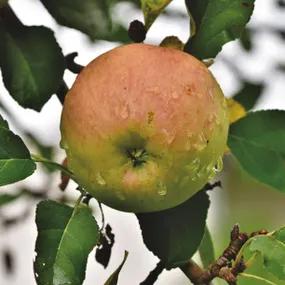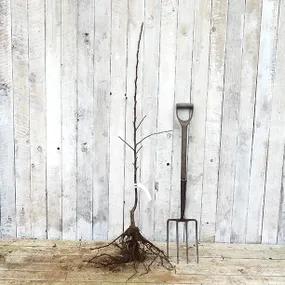Dunkertons Late Apple Trees
Honest Delivery Prices- Cider: Sweet.
- Spur bearer (Good for cordons & espaliers)
- Not self fertile
- Pollinator
- Pollination Group D
- Crops in Early November.
Description
Dunkertons Late Cider Apple Trees
The Dunkertons Late apple tree produces a late season cider apple.
Browse our full range of apple trees for sale or see the full variety of fruit trees available online.
Characteristics of Dunkertons Late Trees:
- Use: Cider. Sweet.
- Spur Bearer: suitable for cordons & espaliers, trained on wires.
- Tree's growth habit: Average vigour.
- Harvest: Early November.
- Cider apples should be pressed for their juice as quickly as possible.
General description of Dunkertons Late:
This sweet cider apple makes a light, fruit brew by itself, almost good enough to qualify for vintage status. Adding a few other types of apple will round out the flavour and give it more body. These fruit are green when they are young, turning slightly yellow (occasionally with a touch of red, if the winter is sunny) when they are ripe.
Rootstocks:
All of our Dunkertons Late trees are grown on MM106 rootstocks.
Pollination Partners for Dunkertons Late:.
Your trees are self sterile and their flowers must be pollinated to make fruit.
Dunkertons Late is in pollination Group D.
This means that they will cross-pollinate with other apple trees in pollination Groups C, D and E.
See our Guide to Apple Tree Pollination for a full list of partners & more tips about pollination.
Dunkertons Late Disease notes:
Disease resistance: Scab
History & Parentage:
This Somerset apple was found by Mr Dunkerton in his orchard in Baltonsborough, during the 1940's.
How Apple Trees are Measured & Delivered:
Our fruit trees are delivered in up to 3 shapes and you can also buy selected apple trees as ready made cordons.
Maiden: This unbranched tree is the smallest starting size. You can train maidens into espaliers and cordons.
Cordon: Dunkertons Late trees are spur-bearers, so they can be made into cordons and espaliers.
Bush: This is a style of freestanding tree with a short trunk of about 60cm. It will grow to about 3 metres tall.
Half-Standard: This is a freestanding style that will grow into a full sized, "normal" apple tree, about 4 metres tall.
Planting Instructions
Notes on planting Dunkertons Late trees:
All fruit trees like a rich soil with decent drainage, protection from the wind and plenty of sun. Apple trees like clay soil, as long as it is not prone to bad waterlogging.
This tree is potentially suitable for organic growing in the more humid West and South of Britain, where scab and canker are more common.
Prepare your site before planting:
Improving the soil in advance of planting your apple trees will help them establish quickly and be productive for years to come. After you have destroyed all the weeds and grass, you can dig the soil over. Remove any stones and rubbish and mix in well rotted compost or manure down to the depth of about 2 spades.
You can do this on planting day, but when you do it weeks or months in advance, you will give the soil time to settle again.
Spacing Dunkertons Late apple trees:
Freestanding bushes: 12-18 feet (4-6 metres) between trees and rows.
Freestanding half-standards: 18-30 feet (6-10 metres) between trees and rows.
In general, allow 1 more metre between rows than there is between each tree in the row.
Wire-trained cordons can be planted in rows 60-100cms apart.
Espaliers need to be spaced at 10-18 feet (3-6 metres) apart.
Watch our video on how to plant a fruit tree for full instructions on planting a bush or half-standard sized tree.
If you are growing a maiden sized apple tree into a freestanding tree, a bamboo cane is enough support.
If you are growing a cordon or espalier, you will need to install training wires to support them.
Remember to water establishing apple trees during dry weather for at least a year after planting.
Apple Tree Planting Accessories:
For bush and half standard apple trees, our tree planting pack includes a wooden stake & rubber tie to support the tree and a biodegradable mulch mat with pegs, which protects the soil at the base of your tree from drying out and stops weeds from sprouting.
We recommend using mycorrhizal "friendly fungi" on the roots of all new trees, especially if your soil is poorly fertile.
After you plant an apple tree, the most important thing to do is water it in dry weather and weed around it. Both of these will be necessary for at least a year after planting. We recommend using a mulch mat as well.
The best tip for helping your tree to establish and quickly become mature and productive is to remove all the fruit that it produces in the first year after planting, as soon as the flowers fade. This will give the tree a chance to develop its roots, which are the foundation of the tree's strength, and sturdy branches that can bear the weight of a heavy crop without snapping.
All fruit trees will need formative pruning during their first years. Although this is not complicated, it is important to research and understand the process so that you can apply it to your particular tree and situation.
Harvesting Dunkertons Late apples:
Your trees should crop in Early November. Dunkertons Late apples should be pressed for their juice as quickly as possible.
Read more about brewing cider here.
Hygiene & Diseases:
Dead, damaged or diseased wood can be pruned off as soon as it appears.
Disinfect your pruning tools between every cut if there is any sign of disease.
Burn or dispose of any diseased material, do not compost it.



